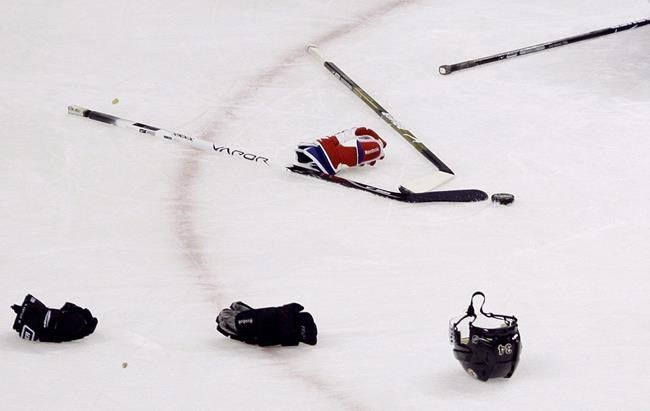The victim of one of junior hockey's most notorious on-ice brawls is still grappling with fighting's place in the game — even as the league where he played moves to further eliminate the practice.
Dr. Bobby Nadeau was a goaltender with the Quebec Major Junior Hockey League's Chicoutimi Sagueneens in 2008 when he was attacked by Quebec Remparts backup netminder Jonathan Roy during a playoff game.
The son of Montreal Canadiens great Patrick Roy skated the length of the rink and pummelled Nadeau, who wasn't injured and didn't fight back. Roy subsequently pleaded guilty to an assault charge, but was granted an absolute discharge that left him without a criminal record.
The ugly incident and its fallout shone a light on violence in hockey, with then-Prime Minister Stephen Harper among those weighing in.
Fast forward some 15 years later, QMJHL team owners agreed last month to effectively ban fighting from their circuit, which, like the Ontario Hockey League and Western Hockey League, largely caters to players aged 16 to 20 under the Canadian Hockey League's umbrella.
"I don't really know what to think," Nadeau, now a dentist in Kingston, Ont., said this week in an interview with The Canadian Press. "We want to progress in the right direction. Before we can find out the answers, it's important to ask the right questions."
A player who drops the gloves in the QMJHL has been assessed an additional 10-minute misconduct on top of the usual five-minute penalty since 2020 following a request from the Quebec government to clamp down.
"I'm not for totally abolishing fighting," Nadeau said. "I've always taken for granted that there's been fighting. But in a way, I think it could be part of the problem of progressing and evolving — that you don't want to get out of the status quo.
"It's important to get out there and start at least thinking about these things."
QMJHL spokesman Maxime Blouin said the league has seen a significant reduction in fighting since 2020, and is further reacting to calls from Isabelle Charest, the minister responsible for sports in the province.
"Black and white in our rule book that fighting is forbidden," Blouin said in an interview. "We are leaning toward more severe sanctions."
Fighting is permitted in North America's professional leagues, including the NHL, while the OHL and WHL have moved to reduce fisticuffs in recent years.
Spokesmen for both of Canada's other major junior leagues said their officials haven't been involved in similar conversations to what's being discussed in the QMJHL.
Blouin added any new decisions on fighting won't be confirmed until after this season. The league is also wading through different scenarios in hopes of coming up with a framework for changes to sanctions, which could include automatic game misconducts and/or suspensions.
Despite his personal history, Nadeau is torn about completely removing something from hockey he still sees as valuable under certain conditions.
"It could lead to more vicious plays," said the 34-year-old from Lac Etchemin, Que. "Will it lead to players feeling more brave with their stick?"
Nadeau would also like to see other dangerous on-ice indiscretions punished more severely.
"Is this going to fully abolish fighting?" he said. "Maybe it'll be at a lower frequency. But if fights become illegal, it'd be equally important to double down on cheap shots and hits to the head."
Toronto Maple Leafs winger Wayne Simmonds, who's been involved in more than 70 fights during his NHL career, isn't a fan of the QMJHL's direction.
"I understand if they want to take out staged fighting," he said of two players tangling immediately after a faceoff. "But fighting within hockey … is more than just the fight.
"(Players) can govern the game."
Toronto teammate Alexander Kerfoot played U.S. college hockey where fighting is banned.
"Slippery slope if you eliminate fighting entirely," he said. "But I also understand that head injuries are a big problem."
The QMJHL has a committee of coaches, general managers and owners to examine next steps, but Nadeau would like to see players, both in junior and pro, involved in response to the government's request.
"We often have policymakers trying to make decisions without consulting the actual people," he said. "The players, what do they think?"
Blouin, who indicated between five and 10 per cent of past concussions in the QMJHL were the result of fighting, said safety is the No. 1 priority.
"Hockey today is not about fighting," he said. "It's about speed, skill.
"That's really what we want to build our league on — the players' abilities."
Nadeau, meanwhile, has sympathy for ex-enforcers and other former players dealing with health concerns blamed on fighting, but as a member of the medical profession, he'd like to see links through data.
"Really important to analyze this correctly," he said. "Is it the fighting? Or is it the body checking that leads to this potential head trauma? Or are there other factors?
"It's important to determine without a doubt it's the fighting that leads to those consequences before we take the decision to totally abolish."
This report by The Canadian Press was first published March 23, 2023.
___
Follow @JClipperton_CP on Twitter.
Joshua Clipperton, The Canadian Press

